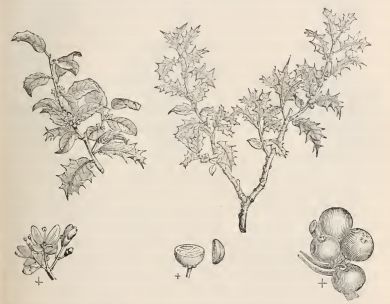nn
n
n
n
n
nThe Holly and the Ivy,nnn
nnNow both are full well grown,nnn
nnOf all the trees that are in the wood,nnn
nnThe Holly bears the crown.n
n
n
nnn
n
n
n
n An ancient belief is that the Holly is the King ofnthe Trees, as Holly is a masculine principle (Ivy, the female principle, is itsnQueen). In ancient Rome, holly was sacred to Saturn and was used to celebratenSaturnalia, the mid-winter feast in his honour, when the Romans brought boughsnof holly into their homes as decorations.
n
n
n
n
n
n
n
nIn the pagan north, celebrants alsonbrought holly boughs and other evergreens to their sacred groves, to replacenthe foliage lost during autumn and to mark their places of worship. In his SylvanFlorifera (1823), Henry Phillips tells us that the early Christiansnfollowed this custom, drawing suspicion away from themselves by also deckingntheir meeting places with evergreens during the winter festivals. Anfolk-etymology reassured their delicate sensibilities by equating ‘holly’nwith ‘holy’, and they found satisfying associations with the holly’snprickles and Christ’s crown of thorns, the white flowers with purity and thenred berries with his blood, whilst the evergreen nature of the plant handilynsymbolised eternal life.
n
n
n
n
n
n
n
nIn fact, ‘holly’ derives from Old English ‘hollin’,n‘holin’ and ‘holme’, which in turn come from the Anglo-Saxon ‘holegn’nand Norse ‘hulf’.’ Holly has male and female trees but the differencenhas nothing to do with the thorny leaves – after a holly tree grows above aboutnten feet, the leaves will be smooth as there is no need for protection fromnbrowsing animals above that height. Another alternative view is that only youngnleaves are smooth and develop spikes as they age, and pollarded hollies wouldnprovide smooth-leaved feed as holly was once cut as fodder for domestic animalsnin the past. An old Yorkshire Mummer’s song, Lyarde, contains thenfollowing lines,
nnn
n
n
n
n“Lyarde is ane olde horse, and may noght wele drawe,nnn
nnHe salle be putt into the parke holyne for to gnawe.”n
n
nnn
n
nHollin is a common place-name in northern England, whichnmay well reflect the practice of growing holly as winter fodder, (as well asnits use as an excellent hedging plant). I’ve mentioned before the practice ofnslaughtering animals prior to winter but, obviously, they couldn’t allnbe killed as that would result in the lack of livestock in the following springnand so some had to be fed through the winter. The evergreen holly was the idealnsolution and was used until improved agricultural techniques in the eighteenthncentury provided alternatives (root crops such as turnip, and better quality silage).
n
n
n
| Holly – Gerarde’s Herbal – 1597 |
n
n
n
nOld country lore says that if prickly holly is the first brought into the homenthen the husband will rule for the next year but if smooth holly is the first,nthen the wife will dominate the household throughout the year; for the maximumngood luck, three types of holly should be used to decorate the home – prickly,nsmooth and variegated (which, in legend, is marked by drops of Mary’s milk,nwhich spilled onto the holly boughs brought to the nativity by the shepherds).nHolly berries contain the alkaloid theobromine, making them dangerouslynpoisonous – if holly is used as a decoration, the berries must be out ofnthe reach of children and pets. The wood of the holly is very white, almostnlike ivory, and extremely hard, it is easily dyed and when dyed black was usednin the past as a substitute for ebony, used for such things as teapot knobs.
n
n
n
n
n
n
nAnother tradition is that the Little People will seek to join in with thenrevels and that the holly gives them a place to hide unseen, whilst the hollynprevents them from doing any harm. Holly and rowan branches were hung outsidenstable doors to prevent the nightmare from entering. The Gentleman’snMagazine of 1779 records that an observer saw a ‘sport’ at an unnamedn‘obscure’ village in Kent, where on a Shrove Tuesday the young girls agednbetween five to eighteen were burning a ‘Holly-Boy’, an effigy made from hollynthat the girls had stolen from the boys. Elsewhere in the village, the boysnwere burning the ‘Ivy-Girl’, which they had taken from the girls. Enquiresnrevealed that this custom had taken place for as long as any villager couldnremember, but no one could explain the significance of this.
n
n
n
 |
| Holly – J C Loudon – Arboretum et Fruticetum Britannicum |
n
n
n
nHolly and thenother evergreens should be removed from the house on Twelfth Night (January 6th),nwith the exception of mistletoe, which should remain in place until Candlemasn(February 2nd). The mistletoe should be retained throughout the yearnas it will protect the house from fire and lightning strike, and the othernevergreens should be carefully disposed of, with due respect, either by burningnor by being fed to the livestock, with attention paid to remove every singlenleaf and berry, as a goblin will come for each that is left behind. RobertnHerrick refers to this in this poem,
nnn
n
n
n
n“DOWN with the Rosemary, and sonnn
nnDown with the Baies & misletoe:nnn
nnDown with the Holly, Ivie, all,nnn
nnWherewith ye drest the Christmas Hall:nnn
nnThat so the superstitious findnnn
nnNo one least Branch there left behind:nnn
nnFor look, how any leaves there bennn
nnNeglected there (maids trust to me)nnn
nnSo many Goblins you shall see.”n
n
nnn
n
n
n
nnn


